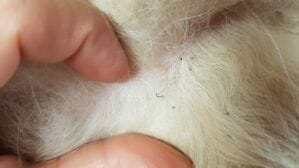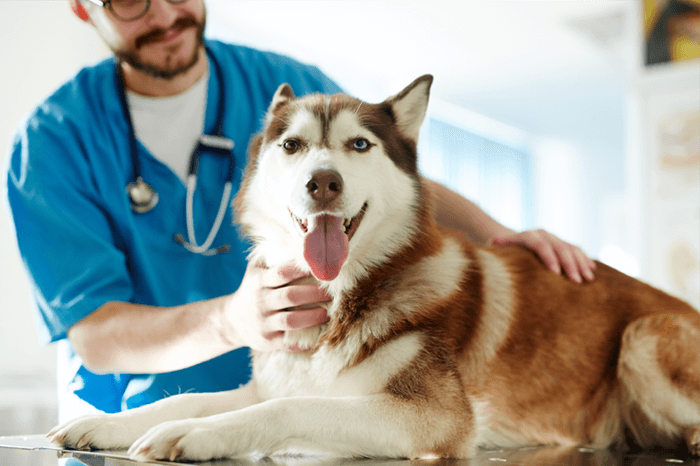Is your dog's skin itchy?
Marina G VeterinarianItch is the most common skin sign in dog, being even the number one cause motivating owners to bring their dogs to veterinarians apart from preventive healthcare. This sign is extremely bothersome, cause terrible discomfort and can alter quality of life of both dog and the family.
Itchy skin is one of the most common skin problems that can affect dogs. However, as common as it is, it’s not always easy to find out why your dog’s skin is itchy as there are many conditions that can cause it.
As itchy skin can be extremely bothersome, it can lead to excessive scratching that results in cutaneous lesions. This is why, when dogs are itchy, we often see skin irritation, wounds, scabs, hot spots, hair loss and even infections.
But, the truth is, we have all seen our dogs scratching their ears or nibbling on their skin and feet, and occasional itching is normal. So as pet owners, when should we be concerned about it?
How can you tell if your dog is feeling itchy?
Usually, if your dog is itchy, you will have no difficulties recognising it!
As you are likely to have experienced yourself, itchy skin can be extremely uncomfortable, and our pets will try to find relief.
When itching is severe, we may see them spending the whole day (and sometimes even the entire night!), constantly scratching and biting themselves to the point of harming the skin. Dogs can even get so desperate that they will not stop scratching, not even to eat or rest.
But, besides biting and scratching, there are some other ways itching can manifest, which include but are not limited to:
- Agitation,
- Incessant licking, nibbling and chewing,
- Head shaking,
- Rubbing against objects, people, walls or the floor,
- Scooting.
Even if you do not see any of these relief-seeking behaviours, you're likely to find signs of scratching, such as red or dark areas on your pet's skin, hair loss, sores, wounds, scabs and infections.
What causes itchy skin in dogs?
Several conditions can make your dog feel itchy, and they range from transient problems to complicated diseases. Oily to flaky skin (seborrhoea) are generally not itchy at their onset (depending on the cause) but can become itchy as the seborrhoea worsens or in case of secondary infection. Here are some of the most common ones that may affect your pets.
External parasites, such as fleas, ticks and mites
If your dog is struggling and constantly scratching, at this point you are probably thinking: 'No, this can't be it, my dog does not have fleas'. This is something you have to consider as the number 1 cause of itch in dogs is fleas. Even if you don’t see fleas, that does not mean your dog does not have fleas. And fleas are not present only in summer even if this is the peak period, they are here all year round. If you run your fingers through your dog’s hair, you may be able to find fleas moving around or flea faeces, which look like black specks of dust, when smudged smearing to red.
Most pet owners are used to treating their pets for parasites at least during some periods of the year, is your dog really protected?
Here are some key aspects to keep in mind:
- Make sure that you follow the manufacturer's recommendations regarding the frequency of treatments.
- Treat all pets in your household, even the indoor-only ones.
- If you've already found external parasites and you're trying to eliminate them, do not forget to treat your home environment as well.
As for mites, there are several types of mites that can affect dogs. Sarcoptic mange (also known as scabies) is an extremely pruritic and contagious disease caused by infection with the Sarcoptes scabiei mite. It’s particularly concerning due to its potential to affect humans as well.
Although rarer than sarcoptic mange, dogs can also be affected by Cheyletiellosis, also known as ‘walking dandruff’, caused by Cheyletiella spp. mites and Trombiculosis, a type of mange caused by mites of the Trombiculosis family at their parasitic larval stage.
Finally, variable levels of pruritus can be seen in dogs affected by Demodicosis, the disease caused by Demodex spp. mites that live within the hair follicles of all dogs. For most dogs, these mites don’t cause a problem but in some cases, the number of mites present increases, causing inflammation of the skin and clinical disease.
Allergies, a common condition causing itchy skin
Just like us, our pets can suffer from allergies, and some dogs get severely itchy skin because of it.
Usually, allergies can be divided into four major groups:
- Allergic reactions – if your pet gets stung by a bee, the area around the sting becomes red, swollen, and itchy because of an exaggerated local inflammatory reaction. In severe cases, they may develop breathing difficulties and should be seen by a vet without delay. You can also see reactions such as skin irritation and itching at the point of contact with contact allergies – for example, from direct contact with an allergen such as a pesticide used in the garden.
- Flea allergy dermatitis (FAD) – FAD is caused by allergens present in fleas' saliva. In dogs with this type of allergy, a single bite from even just one flea can cause severe itchiness. Skin lesions are usually found on the back, the base of the tail and the legs, but they can show up virtually anywhere on your pet's body.
- Food allergy – as the name suggests, it's caused by allergens present in food, such as chicken, eggs, wheat, beef). Apart from itchy skin, dogs may also show gastrointestinal signs, such as vomiting or diarrhoea.
- Atopic dermatitis – atopy is a type of allergy caused by allergens present in your pets' environment, such as pollen, grass, or mites. Depending on what your pet’s allergic to, this can be seasonal. Contact with these allergens causes an exacerbated response from the immune system, resulting in itchy skin, especially on the face, ears, abdomen, feet and perianal area.
Unfortunately, except for allergic reactions, allergies are chronic conditions that can be managed but cannot be cured. If your pet suffers from one type of allergy, they are prone to suffering from other types of allergies as well and are also prone to developing recurrent ear inflammation and infections (otitis). Otitis alone are a common cause of itchiness.
Secondary infections and itchy skin
Did you know that normal skin is home to a healthy population of several types of microorganisms? However, when skin health is impaired, the bacteria and yeasts that live on the skin may grow without control and cause secondary infections.
Bacterial infections
Secondary bacterial infections are usually caused by Staphylococcus pseudintermedius and can vary in severity, depending on the area and layers of skin affected. These can begin as a ‘hot spot’, a lesion that appears suddenly as a red, moist and usually hairless patch of broken skin, which then quickly becomes infected.
Yeast infections
As for yeast infections, these are caused by Malassezia pachydermatis, and tend to develop in skin folds, between the toes and within the ear canal (otitis), although they can appear anywhere in the body. These also tend to have a very particular smell and a recurring nature. `
Other diseases that can cause secondary skin infections
This is when it gets tricky – many diseases that cause skin problems do not cause pruritus (the fancy name for itchiness), such as hypothyroidism, Cushing’s syndrome, and auto-immune diseases, for example. However, if complicated by a secondary infection, pruritus can develop. This makes diagnosing the underlying problem that much more challenging, as the infection will need to be treated before we can further investigate the cause.
Ringworm
Ringworm is a fungal infection that dogs can pick up by being in contact with infected animals or objects. Most often, ringworm does not cause intense pruritus, but some dogs may have mild itchiness or itchiness can develop as a result of secondary infections as mentioned before.
Which dogs can be affected?
All dogs can suffer from itchy skin; however, some breeds are more prone to have itchy skin as they are predisposed to the underlying conditions, such as:
- Allergies – Labrador and Golden Retrievers, German Shepherds, French Bulldogs and Pugs;
- Ear infections – Cocker Spaniels, and Basset Hounds;
- Skin fold infections – Shar-peis, English Bulldogs and other brachycephalic breeds.
What can you do to help your dog?
For more details on how to bring relief to itchy dogs, don’t hesitate to read our dedicated page.
Seek veterinary help
If you notice that your dog itching more than expected or if you see any wounds on their skin, do not hesitate to book an appointment with your vet.
Keep a record of relevant details
Try and assess how much the itchiness is bothering your dog at home. This information can help guide diagnosis, and it can be used to monitor if your dog's condition is improving after treatment has started.
Other relevant information that you can take to your appointment includes what your pet eats, details about their daily routine, and how the skin problems have progressed over time (including pictures!).
Be patient and trust your vet team
To diagnose dermatological conditions, vets usually take a step-by-step approach. This means that finding out the cause of itchy skin, especially when it's due to allergies, can take weeks, even months. In the meantime, you may not see much improvement or even run into setbacks along the way.
This process can be frustrating to both pet owners and vets, which is why it is so important to look for a team that you can trust and talk openly about your concerns.
Managing itchy skin and bringing quick relief from symptoms to your dog
There are four key components in the management of itchy skin:
- Localised, topical treatment with key ingredients that act on the three skin barriers to soothe itchiness, strengthen the damaged barrier and restore the balance of the flora as DOUXO® S3 CALM products for most cases and DOUXO® S3 PYO line where disinfection is needed;
- Medication prescribed by your veterinarian to reduce itching +/- skin inflammation
- Prevent your dog from further damage
- Diagnosing and treating the underlying cause for long-term relief.
From prescription diets to medication and even baths using special shampoos, there are several options available to treat itchy skin. Your vet will recommend what is best suited for your pet as treatment should always be personalised to their specific needs and varies depending on the diagnosis.

























